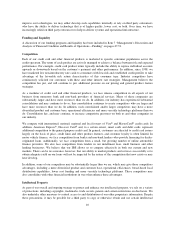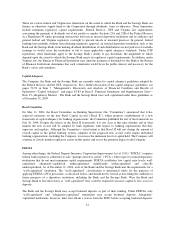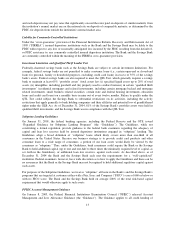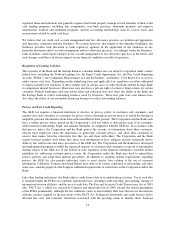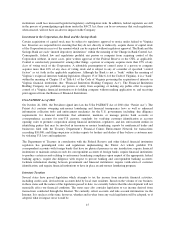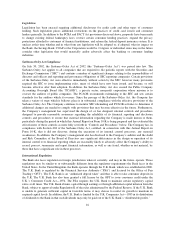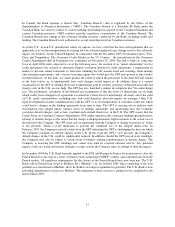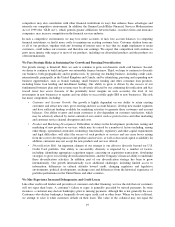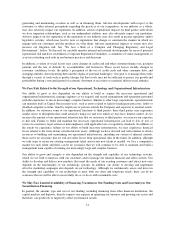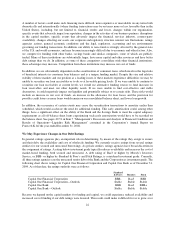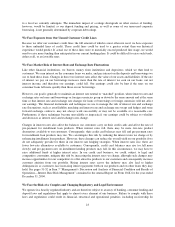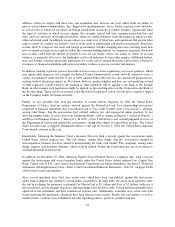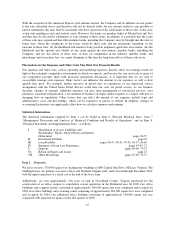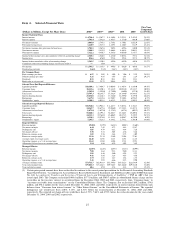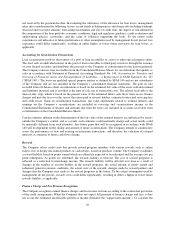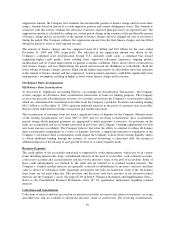Capital One 2004 Annual Report Download - page 43
Download and view the complete annual report
Please find page 43 of the 2004 Capital One annual report below. You can navigate through the pages in the report by either clicking on the pages listed below, or by using the keyword search tool below to find specific information within the annual report.amount of the unpaid loan and we may be unsuccessful in recovering the remaining balance from our customers.
Rising delinquencies and rising rates of bankruptcy are often precursors of future charge-offs and may require us
to increase our allowance for loan losses. Higher charge-off rates and an increase in our allowance for loan losses
may hurt our overall financial performance if we are unable to raise revenue to compensate for these losses, may
adversely impact the performance of our securitizations, and may increase our cost of funds.
Our ability to assess the credit worthiness of our customers may diminish. We market our products to a wide
range of customers including those with less experience with credit products and those with a history of missed
payments. We select our customers, manage their accounts and establish prices and credit limits using
proprietary models and other techniques designed to accurately predict future charge-offs. Our goal is to set
prices and credit limits such that we are appropriately compensated for the credit risk we accept for both high and
low risk customers. We face a risk that the models and approaches we use to select, manage, and underwrite our
customers may become less predictive of future charge-offs due to changes in the competitive environment or in
the economy. Intense competition, a weak economy, or even falling interest rates can adversely affect our actual
charge-offs and our ability to accurately predict future charge-offs. These factors may cause both a decline in the
ability and willingness of our customers to repay their loans and an increase in the frequency with which our
lower risk customers defect to more attractive, competitor products. In our auto finance business, declining used-
car prices reduce the value of our collateral and can adversely affect charge-offs. We attempt to mitigate these
risks by adopting a fairway approach to our predictions of future charge-offs. Nonetheless, there can be no
assurance that we will be able to accurately predict charge-offs, and our failure to do so may adversely affect our
profitability and ability to grow.
The trends that caused the reduction of charge-offs over the course of 2004 may not continue. During that time,
we increased the proportion of lower-risk borrowers in our portfolio and increased the proportion of lower risk
asset classes, like auto loans, relative to credit cards. In addition, in 2004, our managed loan portfolio continued
to grow. Especially in the credit card business, higher growth rates cause lower charge-off rates in the near term.
This is primarily driven by lower charge-offs in the first six to eight months of the life of a pool of new accounts.
Finally, although the U.S. economy has been improving, there can be no assurance that these trends will continue
in the future.
We hold an allowance for expected losses inherent in our existing reported loan portfolio as provided for by the
applicable accounting rules. There can be no assurance, however, that such allowances will be sufficient to
account for actual losses. We record charge-offs according to accounting practices consistent with accounting
and regulatory guidelines and rules. These guidelines and rules, including among other things, the FFIEC
Account Management Guidance, could change and cause our charge-offs to increase for reasons unrelated to the
underlying performance of our portfolio. Unless offset by other changes, this could reduce our profits.
We Face Risk From Economic Downturns
Delinquencies and credit losses in the consumer finance industry generally increase during economic downturns
or recessions. Likewise, consumer demand may decline during an economic downturn or recession. Accordingly,
an economic downturn (either local or national), can hurt our financial performance as accountholders default on
their loans or, in the case of credit card accounts, carry lower balances. Furthermore, because our business model
is to lend across the credit spectrum, we make loans to lower credit quality customers. These customers generally
have higher rates of charge-offs and delinquencies than do higher credit quality customers. Additionally, as we
increasingly market our cards internationally, an economic downturn or recession outside the United States also
could hurt our financial performance.
Reputational Risk and Social Factors May Impact our Results
Our ability to originate and maintain accounts is highly dependent upon consumer and other external perceptions
of our business practices or our financial health. Adverse perceptions regarding our business practices or our
financial health could damage our reputation in both the customer and funding markets, leading to difficulties in
20


